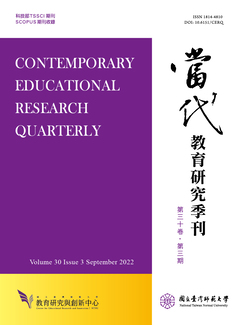

研究目的
在教育改革之際,創意教學扮演著極重要的角色,配合 12 年國 教的推動與新課綱的頒布,教師專業學習社群的成立也更加受到重 視。尤其,教師在參加了專業學習社群之後,對於自己創意教學行 為的程度影響、創意教學信念對於教師參與專業學習社群的動機與 影響情形、教師參與專業學習社群的動機與情形的中介效果,以上 這些都是本研究想要探討的問題與目的。
研究設計/方法/取徑
本研究藉由臺南市 281 位參與專業學習社群的國小教師進行問 卷調查,使用的工具分別為創意教學信念量表、創意教學行為量表、 參與專業學習社群動機、參與專業學習社群情形量表,採用立意抽 樣方式進行調查,以及透過結構方程模式進行分析。
研究發現或結論
經由分析結果得知,創意教學信念對創意教學行為並未有直接 影響;但是,創意教學信念分別可以透過參與專業學習社群動機、 參加專業學習社群情形的中介對創意教學行為產生間接影響;最後, 創意教學信念可以透過參與專業學習社群動機,再透過參與專業學 習社群情形的中介對創意教學行為產生間接影響,換句話說,參與 專業學習社群的動機與情形在創意教學信念與創意教學行為間的中 介角色,獲得本研究的支持。
研究原創性/價值
當討論到創意教學時,教師的信念應聚焦於「創意教學信念」, 而創意教學信念可透過那些因素影響創意教學行為,缺乏相關研究 討論,由此凸顯本研究的價值。此外,過去研究也少討論教師參與 專業學習社群的動機與情形的中介歷程,藉由本研究的進行,可以 具體討論四個變項之間的結構關係。
教育政策建議或實務意涵
針對分析結果,本研究也提出相關建議如積極強化並提升教師 的參與專業學習社群的動機,同時鼓勵教師參加專業學習社群,以 促進教師創意教學行為的展現,以做為相關教育政策之建議。
Purpose
Creative teaching plays a critical role in educational reform. The promotion and the issue of the 12-Year Basic Education Curricula have the establishment of teachers’ professional learning communitybe more emphasized. Especially, how much do teachers reflect on thecreative teaching after involving in professional learning community? Would teaching belief affect the motivation and degree of teachers’ involvement in professional learning community? Do the motivation and participation of teachers involving in professional learning community play the role of mediating variables? These are the questions and objectives discussed in this study.
Design/methodology/approach
Total 281 elementary school teachers involving in professional learning community in Tainan City are preceded the questionnaire survey in this study. The creative teaching belief scale, creative teaching behavior scale, motivation for involving in professional learning community, and participation of involving in professional learning community scale are used as the tools, purposive sampling is applied to the survey, and structural equation model is utilized for the analysis.
Findings/results
The analysis results reveal direct effects of creative teaching belief on creative teaching behavior. However, creative teaching belief would indirectly affect creative teaching behavior through the mediating of involvement motivation and participation in professional learning community. Finally, creative teaching belief could indirectly affect creative teaching behavior through involvement motivation and the participation of professional learning community. In other words, the mediating roles of involvement motivation and participation of professional learning community between creative teaching belief and creative teaching behavior are proven in this study.
Originality/value
Teachers’ belief should focus on “creative teaching belief” when discussing creative teaching. However, it is lack of research discussions related to through what factors creative teaching belief could affect creative teaching behavior. It would highlight the value of this study. Moreover, past research seldom discussed the intervening process of the motivation and situation of teachers involving inprofessional learning community. This study specifically discusses thestructural relationship among four variables.
Suggestions/implications
Aiming at the analysis results, relevant suggestions, e.g. promotionof teachers’ involvement motivation, and encouragement in teachers’ involvement in professional learning community to promote the presentation of creative teaching behavior, are proposed in this study for relevant education policies.

This work is licensed under a Creative Commons Attribution-NonCommercial 3.0 Taiwan License.
Center for Educational Research and Innovation, National Tawain Normal University
162, Ho-Ping East Rd, Sec. 1, Taipei, Taiwan | Tel:+886-2-7749-3670 | E-mail: cerecerq@gmail.com
CERI | NTNU | E-mail Alerts | Open Journal System
© 2014 CERI-NTNU
